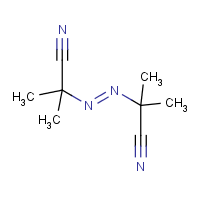Azobis(isobutyronitrile)
Agent Name
Azobis(isobutyronitrile)
CAS Number
78-67-1
Formula
C8-H12-N4
Major Category
Nitrogen Compounds

Synonyms
2,2'-Azobisisobutyronitrile; 2,2'-Azobis(2-methylpropanenitrile); 2,2'-Azobis(2-methylpropionitrile); 2,2'-Azobis(isobutyronitrile); 2,2'-Azodiisobutyronitrile; 2,2'-Dicyano-2,2'-azopropane; 2,2'-Dimethyl-2,2'-azodipropionitrile; AIBN; Aceto AZIB; Aivn; AZDH; Azobisisobutylonitrile; Azobisisobutyronitrile; ChKhZ 57; Genitron; Pianofor An; Poly-Zole AZDN; Porofor 57; Porofor N; Porophor N; Propanenitrile, 2,2'-azobis(2-methyl-; Propionitrile, 2,2'-azobis(2-methyl-; VAZO 64; Vazo; alpha,alpha'-Azodiisobutyric acid dinitrile; alpha,alpha'-Azodiisobutyronitrile; [ChemIDplus] UN3234
Category
Nitriles
Description
White solid; [ICSC] Fine white crystals; [MSDSonline]
Sources/Uses
Used as blowing agent (elastomers and plastics), catalyst (vinyl polymerizations), curing agent (unsaturated polyester resins), and fumigant (when heated); [HSDB]
Comments
Forms hydrogen cyanide in the body; [Merck Index] Decomposed by warming forming toxic fumes such as tetramethylsuccinonitrile and cyanide; May decompose explosively from heating, shock, friction, or concussion; May cause CNS and liver effects; [ICSC] May form explosive mixture of dust in air; May self-decompose or self-ignite from heat, chemical reaction, or impact; [CAMEO] Effects in high-dose animal studies include toxicity to liver and kidneys; [eChemPortal: SIDSUNEP] Highly flammable; May explode from shock, friction, fire, or other source of ignition; May cause irritation; Targets the CNS, liver, and kidneys; [MSDSonline] See "NITRILES."
Biomedical References
Exposure Assessment
Vapor Pressure
0.0067 mm Hg
Lethal Concentration
LC (rat) > 12,000 mg/m3/4h
Explanatory Notes
The Guide in the Emergency Response Guidebook is for "Self-reactive solid type C, temperature controlled." VP from ChemIDplus;
NFPA
may ignite at ambient temp
Adverse Effects
Hepatotoxin
Hepatoxic (a) from occupational exposure (secondary effect) or (b) in animal studies or in humans after ingestion
Nephrotoxin
Yes
Other Poison
Chemical Asphyxiant
Diseases, Processes, and Activities Linked to This Agent
Processes
Industrial Processes with risk of exposure: